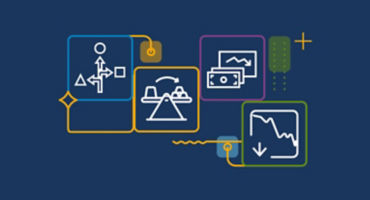A variety of secular trends are spurring innovation and disruption in the global economy and creating what we believe are compelling thematic investment opportunities. In this series of articles, the thematic team takes a close look at some of these trends, the breadth of the opportunity set and the related risks.
Here, we focus on how investors can access the transformative potential of AI. First of all, we believe investor enthusiasm is well founded. We are on the brink of a technological revolution that has major implications for all sectors, companies, labour, and regulators. However, with great potential comes the need for greater discernment, especially as the pace of adoption accelerates. How can a thematic lens help investors separate hype from reality?
In our view, the thematic investor is particularly well positioned to benefit from AI. At its heart, the thematic investment process seeks to identify and exploit the long-term structural trends that are expected to change existing paradigms and drive growth over an extended period. Applying this lens to AI can help investors structure exposure around the long-term drivers of growth, rather than chasing current market trends that may or may not persist. In addition, a thematic approach allows investors to look across sectors and industries at the enablers, innovators and beneficiaries of this technological achievement.
The key question: how will AI transform the world?
Viewing AI as a structural, long-term trend helps contextualise it — offering a way to understand how it might compare to or differ from other structural trends. If AI is, as we believe, most similar to the era of electrification, this can help offer a framework to define and quantify its most compelling investment opportunities.
One of the key questions that we seek to answer when assessing structural trends is this: how exactly will it transform the world?
For AI, we think the answer relates to the concept of productive knowledge. Simply put, productive knowledge is the ability to understand how to do something and then do it. Productive knowledge is a key driver of economic growth, especially today, where companies are built around productive knowledge workers. However, the more complex the task, the more scarce — and expensive — productive knowledge becomes for companies to access. This means companies see diminishing returns to investment as they add resources, creating a bottleneck for growth.
The reason we believe AI is transformative is because we see it increasing the supply of a scarce resource — highly skilled productive knowledge — which, in turn, will enable companies to increase productivity. This pattern — whereby a scarce resource increase in supply is driving productivity — has played out before. A similar bottleneck existed prior to electrification, but back then, the scarce resource was power, not knowledge.
What can electrification tell us about AI?
Looking back to the era of electrification and mechanisation, which accelerated with the development of the modern electrical grid in the 1880s, we observe a number of patterns. Examining these alongside our thematic research points to a potential trajectory for how AI might impact both the wider macroeconomic environment as well as specific industries.
What could change from a macro perspective?
Increase in productivity
As with electrification and mechanisation, AI will enhance productivity, but there are some key differences. The main beneficiary 100 years ago was the manufacturing sector, which saw output — adjusted for population growth — grow seven times from 1859 to 19291. In contrast, AI could benefit a larger number of sectors as well as manufacturing, including trade, IT, finance and professional services, which, in turn, could represent a much larger proportion of modern GDP. If AI were to follow a similar pattern to electrification, we foresee that its beneficiary sectors alone could drive an increase of 1.6% in productivity between 2025 and 2035.
Increase in IT investment
Since the start of the decade, IT investment as a percentage of GDP has been range-bound at around 4% – 5% due to the cost of software2. However, as AI increases the supply of knowledge, a decline in the cost of software should catalyse higher IT spending, potentially hitting a peak of 15% if investment spending follows a similar trajectory to the one taken during electrification.
For labour, a short-term positive but long-term negative?
As ownership of productive knowledge is transferred from the individual to AI tools, AI will raise the productivity of low-skilled workers, making them almost as productive as high-skilled workers. However, for now, AI has accuracy issues, meaning AI tools require a human complement: higher demand for AI will lead to higher demand for labour. But as accuracy improves over time, AI will likely become a headwind for labour, causing workers to reskill and/or move towards sectors where AI cannot fully automate.
How could certain sectors be affected?
The more digitalised the sector, the more quickly it will benefit
Electrification was fastest amongst the industries that relied on power (i.e., manufacturing), but eventually all industries electrified. Similarly, we believe sectors that are “knowledge intensive”, such as IT, media, professional services and finance, will benefit first, followed by sectors that are less so, such as transport, education, retail, government and health care.
Larger companies are better positioned to succeed
In an AI world, scale matters, as greater investment in AI models and access to large data sets results in more accurate outputs. we expect to see more consolidation of smaller companies as returns to scale become increasingly important.
For companies, innovation and production may matter less than monetisation
In our view, AI is most likely to drive productivity and lower costs within two areas of the value chain: innovation (coming up with new business ideas) and production (delivering products and services effectively) (Figure 1). This could lower barriers to entry, increasing competition and meaning that companies find it harder to add value in either of these areas. Instead, companies that focus on and excel in monetisation (owning distribution or the customer relationship) may have a greater edge.
















Trends and transformation distilled: Our 2024 outlook in brief
Our experts explore investment opportunities and risks for the year ahead.
Multiple authors